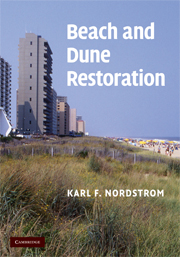Book contents
- Frontmatter
- Contents
- Preface
- Acknowledgments
- 1 The need for restoration
- 2 Beach nourishment and impacts
- 3 Dune building practices and impacts
- 4 Restoring processes, structure, and functions
- 5 Options in spatially restricted environments
- 6 A locally based program for beach and dune restoration
- 7 Stakeholder interests, conflicts, and co-operation
- 8 Research needs
- References
- Index
4 - Restoring processes, structure, and functions
Published online by Cambridge University Press: 14 August 2009
- Frontmatter
- Contents
- Preface
- Acknowledgments
- 1 The need for restoration
- 2 Beach nourishment and impacts
- 3 Dune building practices and impacts
- 4 Restoring processes, structure, and functions
- 5 Options in spatially restricted environments
- 6 A locally based program for beach and dune restoration
- 7 Stakeholder interests, conflicts, and co-operation
- 8 Research needs
- References
- Index
Summary
Increasing complexity and dynamism
Actions that can be taken to set human modified beaches and dunes back on a natural trajectory include restoring the sediment, the basic shapes of landforms, the characteristics of microhabitats, and the process of wave and wind reworking. Considerations for restoring sediment and the basic shapes of landforms were presented in Chapters 2 and 3. This chapter identifies actions that can be taken to ensure that landforms created or managed to achieve a limited number of utility functions and landforms that have become degraded through human use can function more naturally through human actions (or inactions) that will reinitiate cycles of growth and decay and favor reworking by waves and winds. Managing landforms to achieve their full restoration potential involves evaluating them on multiple criteria related to ecological, geomorphological, and social indicators (Table 4.1) and allowing these landforms freedom to evolve with minimal human input. Most efforts taken to manage landscapes to achieve greater natural values may only achieve a few restoration goals, and the mobility of landforms and habitats may be limited by the need to keep projects small because of cost or spatial constraints, but collectively, these efforts reveal the ways many restoration goals can be addressed. Key to long-term success of environmental restoration projects is how much freedom is given to natural processes.
The issue of dynamism
Human alterations to beaches and dunes may introduce temporary instability, but long-term management of coastal resources for human use usually leads to increased stability (Nordstrom 2000).
- Type
- Chapter
- Information
- Beach and Dune Restoration , pp. 66 - 93Publisher: Cambridge University PressPrint publication year: 2008



